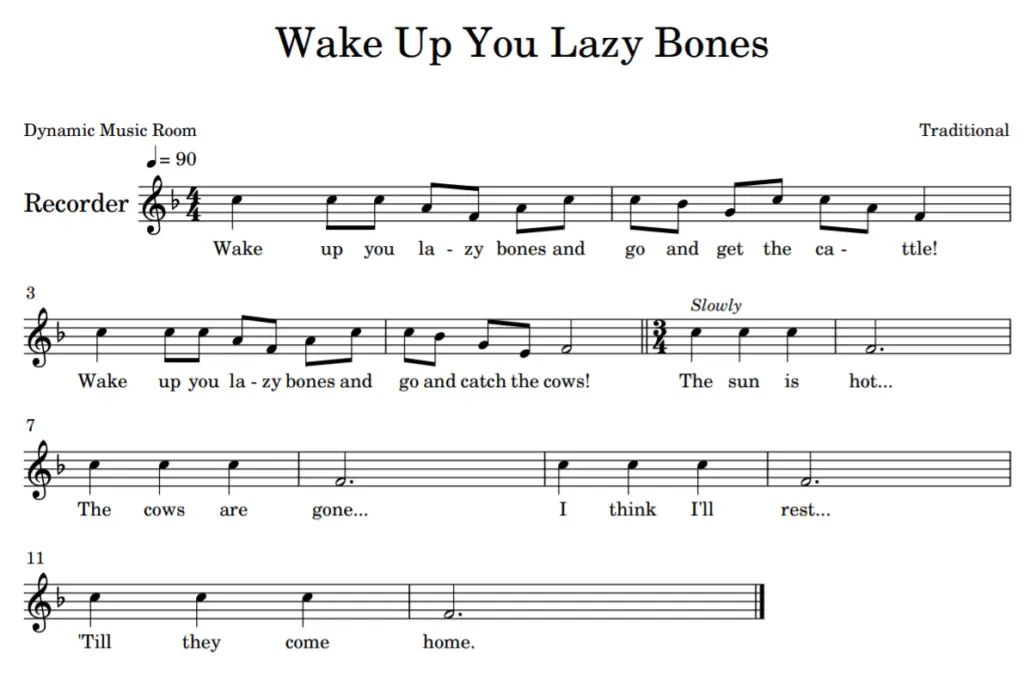There are a ton of songs out there, but there aren’t many that work just as well with Kindergarten as they do with Second grade.
Wake Up You Lazy Bones is one of these songs.
With a highlighted Sol-Do interval and a silly, fun movement, it’s a blast to play (though hard on adult knees!).
In this article, we’ll go over the sheet music, game, and some sample learning activities to do with this fun tune.

Save time with these 60 FREE Music Resources to use in your room right away!
Stop searching the whole internet to find good activities. I’ll help you cut to the chase with my favorite 60 FREE resources.
Table of Contents
Wake Up You Lazy Bones Sheet Music
I use this song both for Kindergarten and for Second grade.
With Kindergarten, it’s for fun and to highlight the high and low pitch difference in the B section.
It’s also great for talking about differences in tempo (speed of the beat).
With second grade, the B section is all Sol-Do, so it’s perfect if this is where you’re at conceptually.

Where I First Heard It: At my Kodaly Level I training with Dr. Joy Nelson. Source from the American Folk Song Collection.
Grade Level: Kindergarten-Second grade
Type: Movement
Tonal Center: Do
Range: Minor 6th
Tone Set: t,Drmfs
Rhythm Set: 4/4 and 3/4: Dotted half note, eighth notes, quarter note
Form: ab
Suggested Key: F Major
Pitch Focus: Sol-Do
Rhythm Focus: 4/4 vs. 3/4
Wake Up You Lazy Bones Lyrics
The words are pretty simple and a lot of fun.
A Section:
Wake up you lazy bones and go and catch the cattle!
Wake up you lazy bones and go and catch the cows!
B Section:
The sun is hot.
The cows are gone.
I think I’ll rest.
‘Till they come home.
Lazy Bones Game
The game is simple, but my kids eat this up like crazy.
There’s no official place people have to stand, so we usually just play it in the circle we usually do our music class in.
During the A section, the students jump up and down with energy. That’s it!
The B section is where it gets tricky. The goal is to eventually get on your hands and knees and rest on the ground.
With each line, you do these moves one at a time:
- Go down on one knee.
- Go down on two knees.
- Put one elbow on the ground.
- Put both elbows on the ground and rest.
The fun part comes with the waiting. Students stay silent and resting on the ground until you (the teacher) burst out with the A section when they jump back up and do the song again.
Pro-tip: Once you’ve taught it, stretch out the silence. The tension makes them so giggly. It’s hilarious!

Save time with these 60 FREE Music Resources to use in your room right away!
Stop searching the whole internet to find good activities. I’ll help you cut to the chase with my favorite 60 FREE resources.
3 Quick Lesson Ideas For Wake Up You Lazy Bones
Here are three quick ideas for using with this song to highlight Sol-Do interval in the B section.
Make Your Own Moves
With older students, change the movements away from those typically used in the game.
These moves should be big, opposite ones to highlight the motion of Sol-Do.
For fun, still let the last move involve them going to sit or lay on the ground.
After you model a couple, hand it over to the students to replace the moves. The important idea is to keep one move higher than the other.
After a bit, replace the lyrics with Sol and Do in the B section.
Here are some movement ideas:
- Hands on head -> Hands on lap
- Hands stretched up -> Touch your toes
- Clap -> Stomp
- Dab -> Floss
- Touch your nose -> Touch your chin
Play On Bells (Or Boomwhackers)
Give out F and high C hand bells (or change the key) to students. I like to split them into two groups, even if there aren’t enough for the whole group to play at once.
When you get to the B section, they play the matching note at the right time.
Then, they pass the bells around so everyone gets a chance to play.
This also works with boomwhackers.
Further Reading: My big list of boomwhacker songs and music
Rewrite The B Section
This activity is surprisingly fun, and it also challenges the students’ brains quite a bit.
On a staff with moveable notes, put the B section up as it originally stands.
Have students sing with words and then with the solfege.
Then, invite them to work as a class (or in small groups) to rearrange the notes (though they still have to use Sol and Do).
Now, sing with solfege and then add the words. It’s pretty hard to do, but sometimes challenges are fun in their own right.

